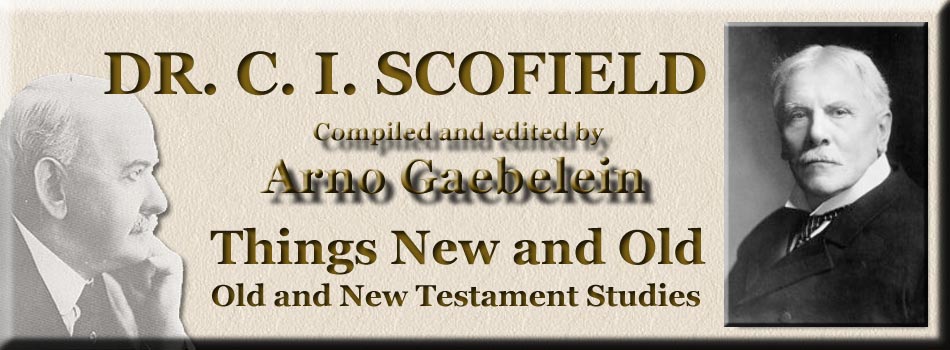
Things New and Old
By Cyrus Ingerson Scofield
Compiled and Edited By Arno Clement Gaebelein
CHRIST RISEN.(Matt, xxviii:1-15.) I. The Analysis. 1. The Empty Tomb (verses 1-6).—From the very moment when Jesus "gave up the ghost" in expiating our sins His triumph began. His bones were not suffered to be broken; His incorruptible body lay in a new tomb; and, when the days in the bowels of the earth were ended an angel rolled back the stone that the true Rock might come forth. 2. The First Message of the New Dispensation (verses 7, 8).—The incarnation ministry of Jesus began with an invitation, ''come and see"; the resurrection began with a message, "go quickly and tell" (John i:39; Matt, xxviii:7). 3. The Reward of Those Who ''Go Quickly and Tell" (verses 8-10).—"As they went, Jesus met them." 4. The Impotence of Hatred (verses 11-15).—The foolish lie is repudiated to-day by all candid readers of the narrative; the resurrection is believed by millions. II. The Heart of the Lesson. The crucifixion of Christ has many meanings, but they all converge upon one great fact—the expiation of man's guilt. But the resurrection of Christ, which also has many meanings, cannot be interpreted by a phrase or a definition. Let us, then, gather up into one view the greater meanings of the resurrection and find in them the heart of that great event. The resurrection of Christ is a fact. It has been said with truth that no event in human history is better authenticated. The evidence upon which an intelligent faith in the stupendous miracle of the resurrection of Christ rests is summarized by Paul in 1 Cor. xv:4-8. (1) The Scriptures required the resurrection (Psa. xvi:8, 11; Acts ii:23-32). (2) After His resurrection He "was seen of Cephas" (Luke xxiv:33, 34). This is not only a touching illustration of the shepherd work of the risen Lord in seeking first a sheep that had strayed, but is an evidential fact of great importance. (3) "Then of the twelve." These were the men who knew Him best, whom it would have been impossible to deceive. Remember, too, that one of the twelve, Thomas, was utterly incredulous and was convinced only by actual evidence. (4) "After that he was seen of above five hundred brethren at once." The witnesses were not only persons who knew the Lord intimately, but they were also numerous, and of a character which excludes the thought of imposture. (5) "After that he was seen of James." It will be remembered that James was the Lord's brother. (6) "Then (again) of all the apostles," The fact of the resurrection does not rest upon one fleeting or phantasmal view of the risen Christ, but upon many and long continued interviews with intervals for reflection. (7) "And last of all he was seen of me also." The testimony of Paul is of final and unanswerable weight. He was a prejudiced and unwilling witness; he saw the risen Lord years after His ascension; he "suffered the loss of all things" because convinced that Jesus was indeed risen from the dead. The resurrection of Jesus affirms the truth of His claims. If Jesus had been but a self-deceived enthusiast honestly supposing Himself to be the Son of God and the Messiah, His death would have ended His claims, for He Himself appealed beforehand to His resurrection as the one great "sign" by which His demand upon the faith and obedience of the world should rest. God could not have raised from the dead an impostor, or a mere religious enthusiast. The resurrection of Christ confirms our justification. He went into death under the burden of our sins; that He rose from the dead is the evidence that His sacrifice was accepted on our behalf. The resurrection of Christ is the proof of the believer's resurrection. "If Jesus died and rose again, even so, them also which sleep in Jesus will God bring with him" (1 Thess. iv:14). This certainly it is which gives us triumph even in the brief of bereavement; because of this we "sorrow not as others, which have no hope," for "then shall be brought to pass the saying which is written, death is swallowed up in victory."
|
|
 |
 |
|
|
|
-
Site Navigation
 Home
Home What's New
What's New Bible
Bible Photos
Photos Hiking
Hiking E-Books
E-Books Genealogy
Genealogy Profile
Free Plug-ins You May Need
Profile
Free Plug-ins You May Need
 Get Java
Get Java.png) Get Flash
Get Flash Get 7-Zip
Get 7-Zip Get Acrobat Reader
Get Acrobat Reader Get TheWORD
Get TheWORD